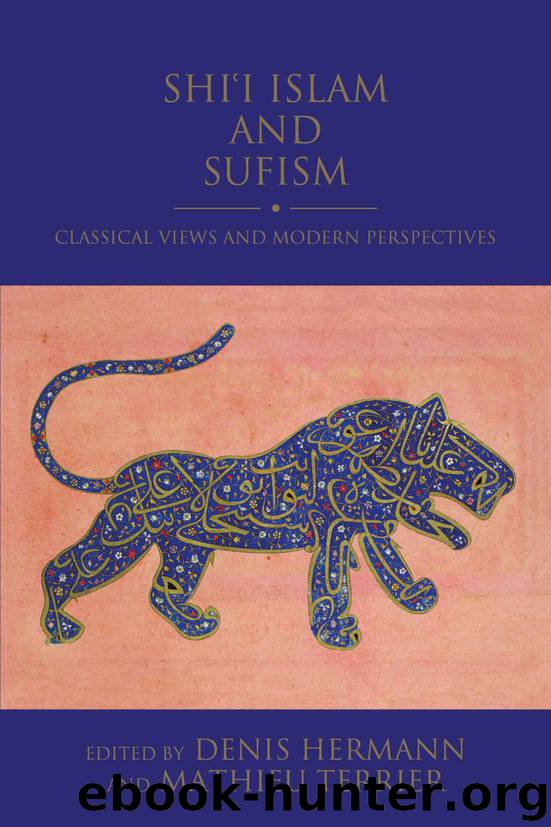Shi'i Islam and Sufism (Shi'i Heritage Series) by Denis Hermann and Mathieu Terrier

Author:Denis Hermann and Mathieu Terrier
Language: eng
Format: azw3
ISBN: 9780755602308
Publisher: Bloomsbury Publishing
Published: 2020-01-22T16:00:00+00:00
Study of the Amīr Sulaymānī waqf in Tehran
The waqf was certainly the most effective means for religious groups in Iran to fend off potential attacks from the political establishment as it provided long-lasting protection for their activities. The waqf here studied was established in 1326 Sh./1947. This date marked the end of a seven-year period of widespread religious revival. Following the exile of Riḍā Shāh to Mauritius in 1941 and the real exercise of power of Muḥammad ‘Alī Furūghī (d. 1321 Sh./1942), the different religious currents felt less inhibited and were thus more active.
During the months of Mihr 1326/September-October 1947, Amīr Muṣṭafā Amīr Sulaymānī, a reputed member of the Ni‘mat Allāhī Sulṭān ‘Alī Shāhī, established as waqf an estate which included two houses with their adjoining courtyards, and partial use of two qanāts. Amīr Sulaymānī bore the prestigious title of ‘Mushīr al-Salṭana Sābiq.’47 His grandfather, Mūsā Khān, belonged to the Quwānlū clan of the Qajar family, and was the maternal uncle (dā’ī) of the future Nāṣir al-Dīn Shāh. His father, ‘Alī Riḍā Khān ‘Aḍud al-Mulk, had served Nāṣir al-Dīn Shāh since childhood as ghulām-bachah.48 In 1271/1854–5, ‘Alī Riḍā Khān ‘Aḍud al-Mulk became head of this group of children who served at the court (ghulām-bachah bāshī) before becoming a personal servant of the Shāh (pīshkhidmat-i Shāh). At the end of his political career, in 1327/1909–10, he was niyābat-i salṭanat (royal guardian) of Aḥmad Shāh (d. 1348/1930) – the latter was then eleven or twelve years old.49 The laqab bestowed upon ‘Alī Riḍā Khān, ‘‘Aḍud al-Mulk’, was rare and prestigious.50 Amīr Sulaymānī rallied the Ni‘mat Allāhī Sulṭān ‘Alī Shāhī brotherhood through the influence of one of his shaykhs, Shaykh Ismā‘īl Dizfūlī (d. 1320/1941), who was responsible for the royal library of the Qajar court. His father, ‘Alī Riḍā Khān ‘Aḍud al-Mulk, made the same choice a few years later.51
The estate dedicated as waqf was in the popular district of Sangilaj, north-east of the bazaar. The first qanāt crossed its whole area and was called ‘Alī Ḥamāmī. The second, Gul-Afshān, was situated outside the property. Amīr Sulaymānī transformed the property into the most important religious centre for the Ni‘mat Allāhī Sulṭān ‘Alī Shāhī community after Baydukht. The property had survived the destruction of the district of Sangilaj, which had been completed by 1309 Sh./1930–1.52 Amīr Sulaymānī then combined several estates in the south of Tehran and around Rayy to establish another waqf in 1340 Sh./1961–2, and founded there a theological school in Mashhad, the Amīr Sulaymānī Khān Qājār Madrasa, with the grandson of Ākhūnd Muḥammad Kāẓim Khurāsānī (d. 1330/1912) at its head.53 He also played a part in financing the embellishment of the Baydukht mausoleum.54
Before this waqf was created, ‘Alī Riḍā Khān ‘Aḍud al-Mulk was already organising ‘āshūrā ceremonies at the residence. Amīr Sulaymānī thus rationalised and perpetuated this activity thanks to the waqf system. The house was built in 1280/1863–4 and was also a ḥusayniyya from 1283/1866–7 onwards.55 Amīr Sulaymānī was the self-designated mutawallī (administrator) there, until his death. The administration was then to be handed over to the quṭb of the brotherhood.
Download
This site does not store any files on its server. We only index and link to content provided by other sites. Please contact the content providers to delete copyright contents if any and email us, we'll remove relevant links or contents immediately.
| Hadith | History |
| Law | Mecca |
| Muhammed | Quran |
| Rituals & Practice | Shi'ism |
| Sufism | Sunnism |
| Theology | Women in Islam |
The History of Jihad: From Muhammad to ISIS by Spencer Robert(2563)
Nine Parts of Desire by Geraldine Brooks(2325)
The Turkish Psychedelic Explosion by Daniel Spicer(2313)
The First Muslim The Story of Muhammad by Lesley Hazleton(2217)
The Essential Rumi by Coleman Barks(1987)
1453 by Roger Crowley(1952)
The Last Mughal by William Dalrymple(1828)
Trickster Travels: A Sixteenth-Century Muslim Between Worlds by Davis Natalie Zemon(1813)
God by Aslan Reza(1610)
Muhammad: His Life Based on the Earliest Sources by Martin Lings(1605)
by Christianity & Islam(1594)
A Concise History of Sunnis and Shi'is by John McHugo(1545)
Magic and Divination in Early Islam by Emilie Savage-Smith;(1498)
No God But God by Reza Aslan(1487)
The Flight of the Intellectuals by Berman Paul(1461)
Art of Betrayal by Gordon Corera(1399)
Nothing to Envy by Barbara Demick(1383)
What the Qur'an Meant by Garry Wills(1359)
Getting Jesus Right: How Muslims Get Jesus and Islam Wrong by James A Beverley & Craig A Evans(1307)
